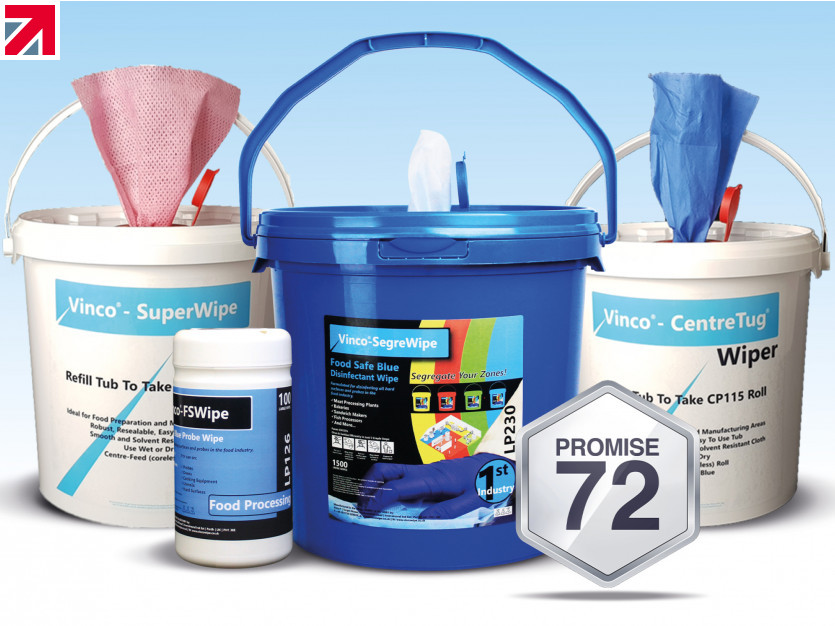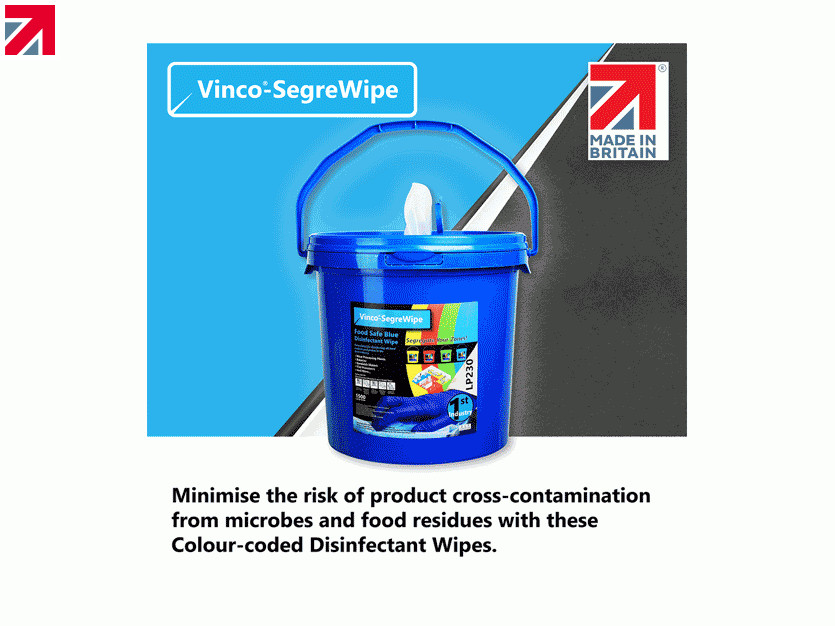The world of wipes is large and can needlessly become very complicated! However, in this article I’ll endeavour to bring some focus into the best wet wipes to use in the following areas:
1) food processing
2) food preparation
3) catering industry
Being part of the technical team at one of UKs leading Wipe Manufacturers, I get a lot of questions every week about the best type of wipe for different applications. I will do my best to provide some guidance so that by the end of this piece you are able to make the most informed decision about the best wipes for your needs.
From sanitising wipes to industrial grime wipes, dry patient wipes to detergent wipes, there are numerous wipes available to the end user creating a whole host of options to take your pick from. So, what exactly are the Best Wipes to use in food areas?
Well, you’re not going to want a wipe that has been manufactured to remove graffiti or a wipe that is suitable for cleansing skin. What you need in the food industry is a wipe for your surfaces to prevent the growth of bacteria and other nasty microorganisms, that if left on food preparation surfaces can lead to food being spoilt and potentially leading to consumer illness. Yes, you have got it, what you need is a wipe that cleans and sanitises your surfaces to ensure a safe food preparation area.
Which wipes are best for disinfecting?
Before we dive into the three core food environments where wipes are used, let’s answer this long-confused question as it will help to understand what positive impact wipes can have in your establishment…
“Sanitising or disinfecting wipes?”
Yes, this question comes up a lot and the two words are often both used interchangeably which brings in misunderstanding. I will also cover ‘clean’ as some wipes are classed as cleaning and sanitising wipes.
Cleaning Wipes
This type of wipe is generally manufactured using a material substrate which is embossed or textured and having a higher absorbency rate than a sanitising or disinfectant wipe. The material will be either a standard non-woven type or a plastic free option. This is so dust, dirt and bits are picked up by the cloth like material rather than just moved around the surface or object being cleaned. This type of wipe would contain some form of soap or detergent solution which helps to loosen any dirt whilst wiping. Industrial wipes would be classed as cleaning wipes and offer effective removal of grime and grease for industries such as construction, automobile and engineering. These wipes are not designed to kill germs but since some of them will be removed by cleaning then this will reduce the number of germs that could spread infections.
Sanitising Wipes
Sanitising wipes are usually developed to lower the number of germs on surfaces or objects. Sanitising wipes are designed to reduce the number of germs and kill bacteria on surfaces using both the wipe substrate (material) and the chemical the wipe is impregnated with. Not every sanitising wipe is intended to kill viruses although many of them are indeed manufactured to kill both bacteria and viruses. The difference here is down to the type of active solution that is contained within the wipe. Typically, the wipe material tends to be of a slightly heavier grade than specific disinfectant wipes with embossing or apertures to trap any dirt or grime. If the wipe has been designed to be dual purpose, a nonwoven grade of material still ensures that the wipe solution is deposited on the surface post wiping to ensure the surface is not only cleaned but also disinfected.
Disinfectant Wipes
This class of wipe is designed and manufactured for disinfecting predominantly in mind, which is the purpose of killing microorganisms on surfaces and objects. Wipes which are best for disinfecting contain a solution effective against microorganisms (including viruses) and the material these are made from tends to be light weight and designed to deposit or ‘let go’ of the active solution onto surfaces or objects rather than retain the liquid. This ensures the disinfecting solution is left behind on the surface to effectively kill any bacterial or viral organisms. Disinfectant wipes should be used where the germs, bacteria and viruses need to be eliminated so they do not spread for example via food products being prepared.
What is the active ingredient in my wipes?
I have mentioned active solution a number of times so let’s cover this point off and then we can really get serious about the best wipe for you. Often the question gets asked, are Disinfecting Wipes Food Safe, and really the answer to this depends primarily on what type of active solution has been used within the wipe and the type of wipe material used. Not all disinfecting wipes are food safe because often the solution used is a QUAT (Quarternium Compound) make up which research has shown can taint food and if the solution contaminates any food this has the slight possibility of causing harm to anyone who then eats that food. Therefore, disinfectants used in the food industry are controlled by a number of legislations with one being Regulation (EC) No 396/2005 1 which covers maximum residue levels and prevents a QUAT solution being used in a food safe wipe. However, the good news is that there are other disinfectants available which are suitable for use within the food industry.
Often, we get asked whether certain brands of wipes are ok for use in certain areas i.e. ‘are Dettol wipes food safe?’ It is difficult to answer this question directly without knowing the exact type of wipe being referred to within that brand. As mentioned at the beginning of this article there are many wipes to choose from in today’s marketing with each having their designed purpose. Typically, with household brands this could include washroom wipes, pet wipes, kitchen wipes for example, with the latter obviously manufactured for the purpose stated so one would think the wipe would be food safe. And on the flip side to this, can you use bathroom wipes in kitchens? This is not recommended as often a QUAT solution will be used in a bathroom or washroom wipe which as explained above is not recommended for use in food preparation or kitchen areas.
Antibacterial wipes can be used on dishes, crockery, cutlery etc but wipes containing QUATs should be avoided for this application and a food safe disinfectant wipe used.
So now we have these areas straightened out we have a clearer picture now of what’s required to get the desired results in the following areas.
The best wipes for food areas.
Food Processing Wipes
A Food Processing area is usually the term used for any establishment or area which runs a variety of operations by which any raw food or ingredients are prepared and made suitable for eating, cooking or storing. Typically, these would be commercial business that are preparing food for supermarkets, restaurants etc. Probe Wipes are a classic product example used in this environment.
Wipes suitable for these types of areas would be a Disinfectant Wipe packaged in a large tub containing approx. 1500 wipes. This large volume leads to efficiency on production lines where operative don’t keep running out of wipes. The best wipes should be packaged in a reusable plastic tub which not only is very tough and shatter proof but can also be reused by utilising a refill bag of wipes.
The wipe itself should be impregnated with a food safe chemical solution and should not contain QUAT (Quarternium Compound) as covered earlier.
Food Preparation Wipes
Food preparation areas often contain cooking facilities and any surface that is used for the preparation of food. An example of this would be found at a restaurant or hotel where food is prepared for either guests eating in or takeaway. Suitable wipes would be a disinfectant wipe as used in food processing areas but often more suitable in a smaller size of tub such as a 200 or 500 sheet option. Requirement here would also be for the wipe to be blue so it can be easily detected should a wipe fall into any food item during preparation.
Catering Wipes
Catering wipes are designed for and are most used front of house in restaurant and hotel settings. This would predominantly be for cleaning and sanitising tables where guests would eat at. A QUAT based product is the norm for this type of wipe as food is not eaten direct from the surface that is being wiped – or not often anyhow! QUAT based wipes are used in this area due to a food safe wipe not being a requirement and the active has greater efficacy on most types of surfaces - both porous and non-porous - with a short contact time ensuring a quick kill rate. A typical size of tub for this application would again be a tub of 200 or 500 wipes with some front of house personnel taking the initiative and carrying a small pocket sized 100 wipe cannister with them for ease of use and keeping their area of responsibility clean and germ free.
So hopefully with this guide you now have a far clearer picture of what wipe you need in your establishment to ensure germs are controlled or eliminated so that a safe environment is achieved which will pass food preparation inspection or audit.
Do you require further advice?
Our Team is willing to answer any questions you may have. You can email sales@hcinnovations.co.uk, Live Chat or call on 01738 629839 (option 1) where our helpful team will assist with all the advice and support you require.
Find out more about HC Innovations Ltd on their member profile page here
Member-created content 3 years ago | From members

